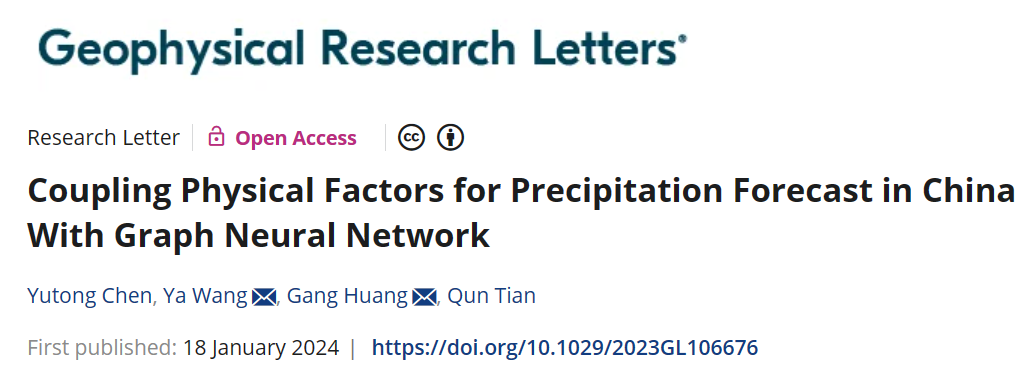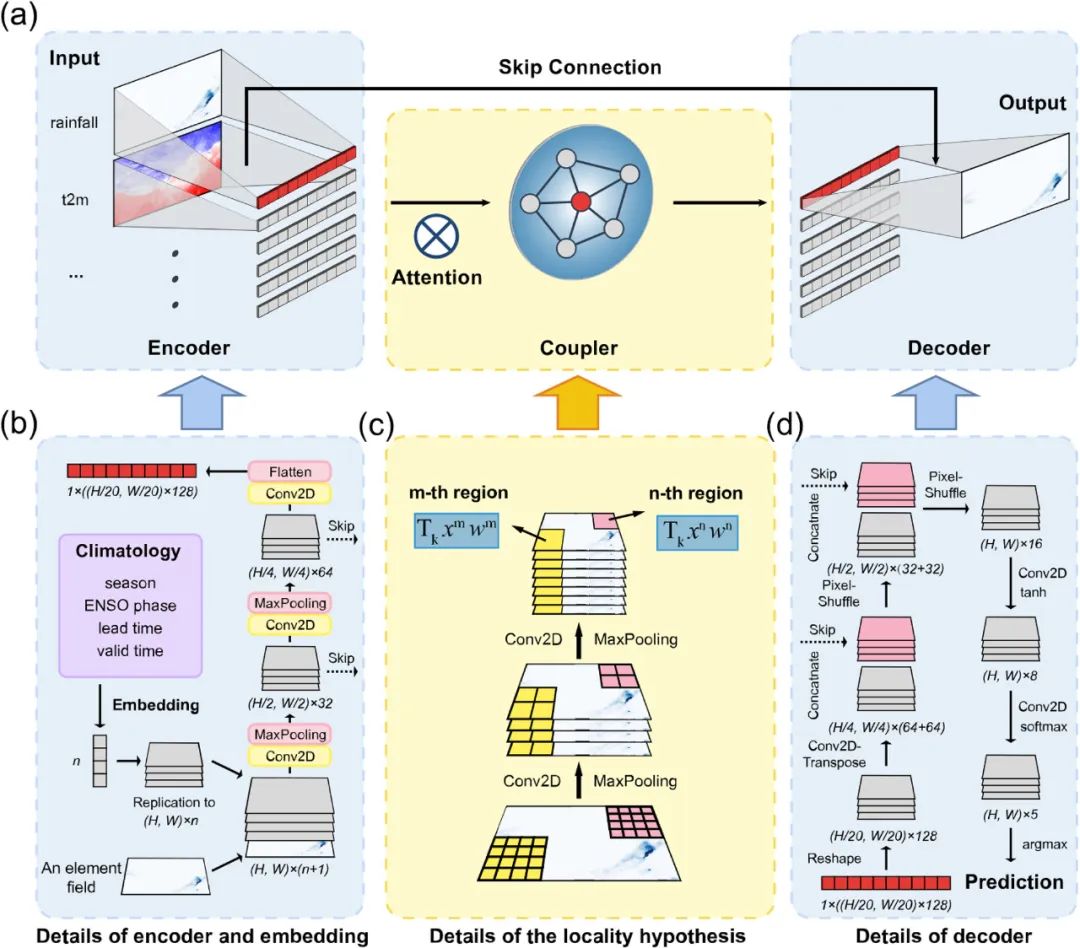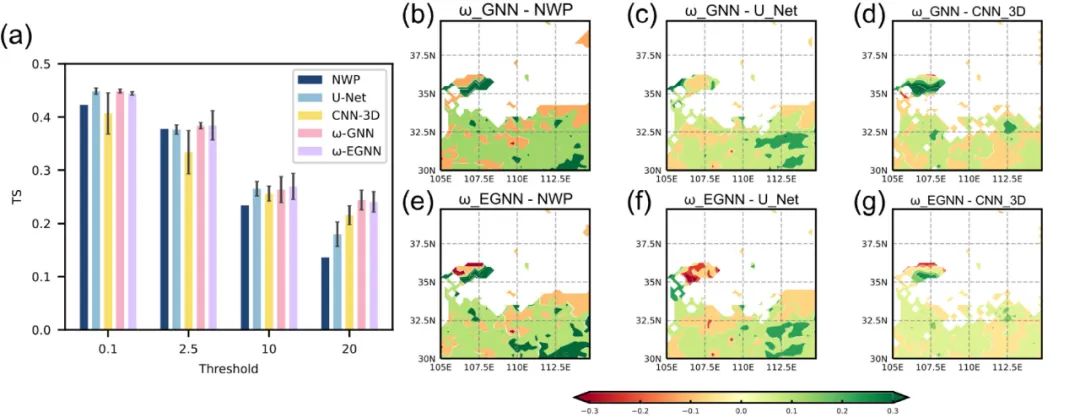 Technology peripherals
Technology peripherals
 AI
AI
 Applying physically coupled graph neural networks to improve precipitation forecasting skills at the Institute of Atmospheric Physics, Chinese Academy of Sciences
Applying physically coupled graph neural networks to improve precipitation forecasting skills at the Institute of Atmospheric Physics, Chinese Academy of Sciences
Applying physically coupled graph neural networks to improve precipitation forecasting skills at the Institute of Atmospheric Physics, Chinese Academy of Sciences

Editor | ScienceAI
In the era of large models, the effects of purely data-driven meteorological and climate models have gradually caught up with or even surpassed numerical models.
However, existing large-scale meteorological and climate models still have some problems. For example, the physical consistency in the model is not high enough, which limits the ability to predict complex weather and climate phenomena such as precipitation. In addition, the forecast effect of divergent wind is not satisfactory. These issues require further research and improvement to improve the prediction accuracy and reliability of the model.
At present, combining physics, atmospheric dynamics and deep learning models is an important way to solve the bottleneck problem.
Recently, the team of researcher Huang Gang from the Institute of Atmospheric Physics, Chinese Academy of Sciences, based on the data and computing power support of the Earth System Numerical Simulation Device (Huan), starting from the perspective of the coupling relationship of physical variables, combined with the figure The neural network imposes physical soft constraints on multiple variables, improves the precipitation forecasting skills of numerical models, and makes some attempts and explorations in the integration of physics and AI.
The research was titled "Coupling Physical Factors for Precipitation Forecast in China With Graph Neural Network" and was published in "Geophysical Research Letters" on January 18.

Paper link: https://doi.org/10.1029/2023GL106676
In response to the difficult issues of precipitation forecasting, especially the forecasting of heavy precipitation, Our team solved the problem by starting from the influencing factors and occurrence mechanism of precipitation, combining the omega equation and the water vapor equation, etc., to screen variables and build a variable coupling graph network.
The Omega equation and the water vapor equation describe vertical movement and water vapor changes respectively, both of which are important factors affecting precipitation. From the perspective of graph network, the aforementioned equation reflects the relationship between the nonlinear combination of basic physical quantities (temperature, wind, humidity, etc.) and the key elements of precipitation. Therefore, it can be abstracted into a graph network, and through the variables between the graph network (nodes) and the relationships between variables to represent the combination and coupling between different physical variables.
At the same time, taking into account the impact of climate factors on weather scales, especially the systematic differences in model errors under different climate backgrounds, this study combined sparse data such as season, ENSO and other climate factors and reporting time Use entity embedding technology to embed the correction model to distinguish errors in different backgrounds.
In addition, for the precipitation process, this study made local improvements to the graph neural network ChebNet, so that it can basically maintain the effect while avoiding global operations and greatly reducing the computational complexity.

Figure 1: Schematic of the omega-GNN model. (Source: paper)
Model comparison results show that the two physically constrained models omega-GNN and omega-EGNN proposed in this study significantly improve the precipitation forecasting skills of each category compared with the numerical model, and at the same time their performance Better than the current mainstream deep learning models without physical constraints (such as U-NET, 3D-CNN, etc.).
In addition, this study performed ten sets of perturbations on all deep learning models, allowing them to perform ensemble forecasts. Combining diagnosis and case analysis, it is found that the model with physical constraints is significantly better than the model without physical constraints. For the prediction of heavy precipitation, the consistency between the omega-GNN model and the omega-EGNN model ensemble is higher, and the forecasting skills are better.

Figure 2: Each model’s (a) TS score, (b-g) spatial distribution of TS differences relative to the numerical model (precipitation above the 20mm/6h threshold). (Source: paper)
Researcher Huang Gang, the corresponding author of the paper, said: "Our team has accumulated a lot in the direction of climate dynamics. In recent years, we have made some attempts to use AI to improve weather and climate predictions, and have achieved many related results. Won relevant competition awards for the first time. In the era of large AI models, how to integrate physics with AI is a big issue, and there are many ways and ideas for integration. We combined some thoughts on atmosphere and climate dynamics to soft-soften the model from the perspective of physical coupling. Constraints, some attempts have been made in this direction, hoping to provide some incremental information for related fields."
The research was conducted by master students Chen Yutong, Dr. Wang Ya, Researcher Huang Gang and the Institute of Atmospheric Physics, Chinese Academy of Sciences Completed in collaboration with Dr. Tian Qun from the Guangzhou Institute of Tropical Marine Meteorology, China Meteorological Administration.
Reference content: https://iap.cas.cn/gb/xwdt/kyjz/202401/t20240119_6959543.html
The above is the detailed content of Applying physically coupled graph neural networks to improve precipitation forecasting skills at the Institute of Atmospheric Physics, Chinese Academy of Sciences. For more information, please follow other related articles on the PHP Chinese website!

Hot AI Tools

Undresser.AI Undress
AI-powered app for creating realistic nude photos

AI Clothes Remover
Online AI tool for removing clothes from photos.

Undress AI Tool
Undress images for free

Clothoff.io
AI clothes remover

AI Hentai Generator
Generate AI Hentai for free.

Hot Article

Hot Tools

Notepad++7.3.1
Easy-to-use and free code editor

SublimeText3 Chinese version
Chinese version, very easy to use

Zend Studio 13.0.1
Powerful PHP integrated development environment

Dreamweaver CS6
Visual web development tools

SublimeText3 Mac version
God-level code editing software (SublimeText3)

Hot Topics
 1378
1378
 52
52
 DeepMind robot plays table tennis, and its forehand and backhand slip into the air, completely defeating human beginners
Aug 09, 2024 pm 04:01 PM
DeepMind robot plays table tennis, and its forehand and backhand slip into the air, completely defeating human beginners
Aug 09, 2024 pm 04:01 PM
But maybe he can’t defeat the old man in the park? The Paris Olympic Games are in full swing, and table tennis has attracted much attention. At the same time, robots have also made new breakthroughs in playing table tennis. Just now, DeepMind proposed the first learning robot agent that can reach the level of human amateur players in competitive table tennis. Paper address: https://arxiv.org/pdf/2408.03906 How good is the DeepMind robot at playing table tennis? Probably on par with human amateur players: both forehand and backhand: the opponent uses a variety of playing styles, and the robot can also withstand: receiving serves with different spins: However, the intensity of the game does not seem to be as intense as the old man in the park. For robots, table tennis
 The first mechanical claw! Yuanluobao appeared at the 2024 World Robot Conference and released the first chess robot that can enter the home
Aug 21, 2024 pm 07:33 PM
The first mechanical claw! Yuanluobao appeared at the 2024 World Robot Conference and released the first chess robot that can enter the home
Aug 21, 2024 pm 07:33 PM
On August 21, the 2024 World Robot Conference was grandly held in Beijing. SenseTime's home robot brand "Yuanluobot SenseRobot" has unveiled its entire family of products, and recently released the Yuanluobot AI chess-playing robot - Chess Professional Edition (hereinafter referred to as "Yuanluobot SenseRobot"), becoming the world's first A chess robot for the home. As the third chess-playing robot product of Yuanluobo, the new Guoxiang robot has undergone a large number of special technical upgrades and innovations in AI and engineering machinery. For the first time, it has realized the ability to pick up three-dimensional chess pieces through mechanical claws on a home robot, and perform human-machine Functions such as chess playing, everyone playing chess, notation review, etc.
 Claude has become lazy too! Netizen: Learn to give yourself a holiday
Sep 02, 2024 pm 01:56 PM
Claude has become lazy too! Netizen: Learn to give yourself a holiday
Sep 02, 2024 pm 01:56 PM
The start of school is about to begin, and it’s not just the students who are about to start the new semester who should take care of themselves, but also the large AI models. Some time ago, Reddit was filled with netizens complaining that Claude was getting lazy. "Its level has dropped a lot, it often pauses, and even the output becomes very short. In the first week of release, it could translate a full 4-page document at once, but now it can't even output half a page!" https:// www.reddit.com/r/ClaudeAI/comments/1by8rw8/something_just_feels_wrong_with_claude_in_the/ in a post titled "Totally disappointed with Claude", full of
 At the World Robot Conference, this domestic robot carrying 'the hope of future elderly care' was surrounded
Aug 22, 2024 pm 10:35 PM
At the World Robot Conference, this domestic robot carrying 'the hope of future elderly care' was surrounded
Aug 22, 2024 pm 10:35 PM
At the World Robot Conference being held in Beijing, the display of humanoid robots has become the absolute focus of the scene. At the Stardust Intelligent booth, the AI robot assistant S1 performed three major performances of dulcimer, martial arts, and calligraphy in one exhibition area, capable of both literary and martial arts. , attracted a large number of professional audiences and media. The elegant playing on the elastic strings allows the S1 to demonstrate fine operation and absolute control with speed, strength and precision. CCTV News conducted a special report on the imitation learning and intelligent control behind "Calligraphy". Company founder Lai Jie explained that behind the silky movements, the hardware side pursues the best force control and the most human-like body indicators (speed, load) etc.), but on the AI side, the real movement data of people is collected, allowing the robot to become stronger when it encounters a strong situation and learn to evolve quickly. And agile
 ACL 2024 Awards Announced: One of the Best Papers on Oracle Deciphering by HuaTech, GloVe Time Test Award
Aug 15, 2024 pm 04:37 PM
ACL 2024 Awards Announced: One of the Best Papers on Oracle Deciphering by HuaTech, GloVe Time Test Award
Aug 15, 2024 pm 04:37 PM
At this ACL conference, contributors have gained a lot. The six-day ACL2024 is being held in Bangkok, Thailand. ACL is the top international conference in the field of computational linguistics and natural language processing. It is organized by the International Association for Computational Linguistics and is held annually. ACL has always ranked first in academic influence in the field of NLP, and it is also a CCF-A recommended conference. This year's ACL conference is the 62nd and has received more than 400 cutting-edge works in the field of NLP. Yesterday afternoon, the conference announced the best paper and other awards. This time, there are 7 Best Paper Awards (two unpublished), 1 Best Theme Paper Award, and 35 Outstanding Paper Awards. The conference also awarded 3 Resource Paper Awards (ResourceAward) and Social Impact Award (
 Hongmeng Smart Travel S9 and full-scenario new product launch conference, a number of blockbuster new products were released together
Aug 08, 2024 am 07:02 AM
Hongmeng Smart Travel S9 and full-scenario new product launch conference, a number of blockbuster new products were released together
Aug 08, 2024 am 07:02 AM
This afternoon, Hongmeng Zhixing officially welcomed new brands and new cars. On August 6, Huawei held the Hongmeng Smart Xingxing S9 and Huawei full-scenario new product launch conference, bringing the panoramic smart flagship sedan Xiangjie S9, the new M7Pro and Huawei novaFlip, MatePad Pro 12.2 inches, the new MatePad Air, Huawei Bisheng With many new all-scenario smart products including the laser printer X1 series, FreeBuds6i, WATCHFIT3 and smart screen S5Pro, from smart travel, smart office to smart wear, Huawei continues to build a full-scenario smart ecosystem to bring consumers a smart experience of the Internet of Everything. Hongmeng Zhixing: In-depth empowerment to promote the upgrading of the smart car industry Huawei joins hands with Chinese automotive industry partners to provide
 Li Feifei's team proposed ReKep to give robots spatial intelligence and integrate GPT-4o
Sep 03, 2024 pm 05:18 PM
Li Feifei's team proposed ReKep to give robots spatial intelligence and integrate GPT-4o
Sep 03, 2024 pm 05:18 PM
Deep integration of vision and robot learning. When two robot hands work together smoothly to fold clothes, pour tea, and pack shoes, coupled with the 1X humanoid robot NEO that has been making headlines recently, you may have a feeling: we seem to be entering the age of robots. In fact, these silky movements are the product of advanced robotic technology + exquisite frame design + multi-modal large models. We know that useful robots often require complex and exquisite interactions with the environment, and the environment can be represented as constraints in the spatial and temporal domains. For example, if you want a robot to pour tea, the robot first needs to grasp the handle of the teapot and keep it upright without spilling the tea, then move it smoothly until the mouth of the pot is aligned with the mouth of the cup, and then tilt the teapot at a certain angle. . this
 Distributed Artificial Intelligence Conference DAI 2024 Call for Papers: Agent Day, Richard Sutton, the father of reinforcement learning, will attend! Yan Shuicheng, Sergey Levine and DeepMind scientists will give keynote speeches
Aug 22, 2024 pm 08:02 PM
Distributed Artificial Intelligence Conference DAI 2024 Call for Papers: Agent Day, Richard Sutton, the father of reinforcement learning, will attend! Yan Shuicheng, Sergey Levine and DeepMind scientists will give keynote speeches
Aug 22, 2024 pm 08:02 PM
Conference Introduction With the rapid development of science and technology, artificial intelligence has become an important force in promoting social progress. In this era, we are fortunate to witness and participate in the innovation and application of Distributed Artificial Intelligence (DAI). Distributed artificial intelligence is an important branch of the field of artificial intelligence, which has attracted more and more attention in recent years. Agents based on large language models (LLM) have suddenly emerged. By combining the powerful language understanding and generation capabilities of large models, they have shown great potential in natural language interaction, knowledge reasoning, task planning, etc. AIAgent is taking over the big language model and has become a hot topic in the current AI circle. Au



